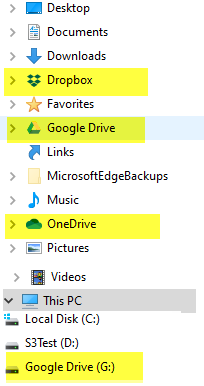Adding Cloud Storage to File Explorer
Easily add your cloud drives to your file explorer for ImageRamp batch processing.
Using Cloud services for your batch processing needs, is easy with many of the available options for storing you business documents. With online storage services, you now have access to unlimited storage and automated backup services. Here we will look at some of the more popular cloud storage options available, including Dropbox, Google Drive, and OneDrive, and configure each with our file explorer system. Each one offers different benefits and varying levels of security, so be sure to choose the right option based on your specific needs.
It's easy to add cloud storage to the Microsoft File Explorer application, on your Windows desktop computer running Windows 10 or 11. Here are the simple steps to follow:
1. Adding Microsoft OneDrive to File Explorer
OneDrive is a popular cloud-storage services that is included with the Windows operating system. As expected, it is well integrated with the operating system coming from the same software manufacturer.
If you want to pin your OneDrive storage to File Explorer, follow these steps:
To launch OneDrive, begin by entering "OneDrive" into the Start search box. Once it appears in the results, select it to open.
If you already have a OneDrive account, simply complete the credentials with your email address and password. If you do not have an account set up, follow the instructions to set one up.
Select your OneDrive folder by following the on-screen instructions. If you've logged in to OneDrive on your computer before, there's a chance that you have an existing OneDrive folder; if so, simply click "Use this folder" and continue.
Upon completion of these steps, your OneDrive files will instantly appear in File Explorer. With this newfound capability, you can quickly and simply move documents into or out of OneDrive with ease!
2. Adding Google Drive to File Explorer
Google Drive is another popular cloud storage option for Windows users. Google Drive is ideal for small businesses and is free for the first 15GB, after which a nominal fee of $2,3 or $10/month gets you up to 2GB. Larger storage plans are also available.
To integrate Google Drive into your Windows File Explorer, follow these steps:
To get started, download Google Drive for Desktop and sign in with your Google account. Make sure you're using the account that has your Google Drive files on it.
After completing the installation and signing in, Google Drive will be visible as the “G:” drive in File Explorer of Windows.
Your G: drive will operate similarly to a traditional hard disk on your device. Whenever you make any changes or additions, they'll instantly be synced with Google Drive. However, by default, deletions made from your PC are not removed from the cloud unless you select this option.
3. Adding Dropbox to File Explorer
For both personal and professional use, Dropbox is a widely-used cloud storage platform. It offers flexible pricing plans, high levels of security, and the ability to collaborate with others on shared files.
To get Dropbox set up in File Explorer, simply follow these steps:
Head over to the Dropbox website to begin the process. From there, simply click the "Download the app" button and you'll be on your way to secure cloud storage.
To get started, open the downloaded installer file and input your account email address as well as password. After that click “Sign in” to move forward.
After successfully signing in, click on the "Open my Dropbox" button, and then click "Get Started."
Click "Next" and then click "Finish." You should see the Dropbox drive show up in File Explorer. With your Dropbox account set up in File Explorer, you can now easily access and share your files on the go.
Now, you have easy access to all of your cloud-stored files on Dropbox. This means that you can collaborate with others in real time and share your files with ease. Whether it's for personal or professional use, Dropbox offers a reliable, secure platform to store your files in the cloud.
